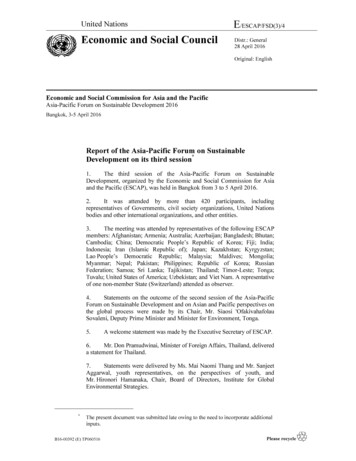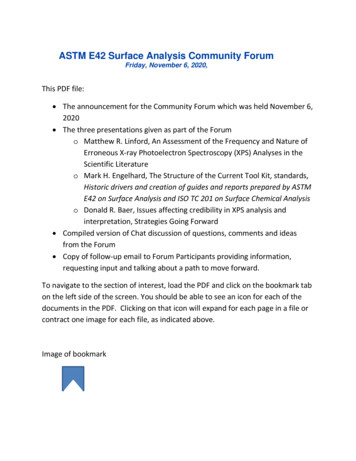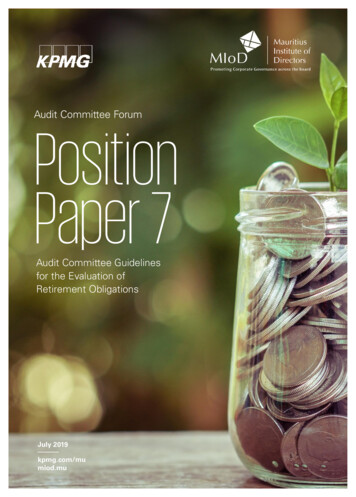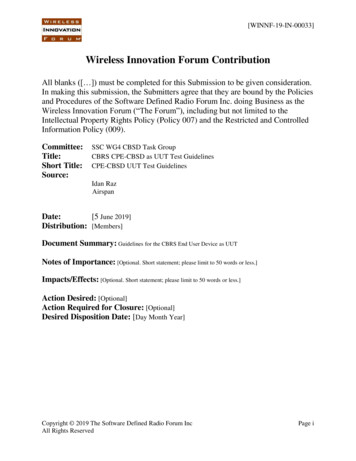
Transcription
Oxfordshire CountrysideAccess ForumSecond meeting of 2013/14County Hall, Oxford, OX1 1NETuesday 24th September 2013 10am - 12.30pmAGENDA2013 (2)Item10.00Coffee/tea available from 09.45am1Apologies for absence,2Declarations of interest- to declare any personal or prejudicial interests3Confirm the minutes of 30th April 2013 (2013/1)10.154Matters arising10.305Local Nature Partnership update– Clare Mowbray10.406Parish Path Wardens update – John Orchard10.557Summer path management briefing – Hugh Potter11.008Towards a standard of provision for maintaining Oxfordshire’s publicrights of way – Hugh Potter11.309Countryside Access Management Plan update – Paul Harris11.5010Draft OCAF Annual Report ( Apr 12 to Mar 13) for approval12.0011Notices and any other issues. Date of next meetings: January 21st,Ramblers summary of changes to rights of way legislation, NaturalEngland letter to s94 bodies12.1512Questions from members of public/observersn.b. all times are indicative onlyOxfordshire Countryside Access Forum is a Local Access Forum - an independent advisorybody, established and administered by Oxfordshire County Council to assist with improvingaccess to Oxfordshire’s countryside under s94 of the Countryside and Rights of Way Act 2000.Contact any member via the OCAF Secretariat: Oxfordshire County Council, CountrysideService, Signal Court, Old Station Way, Eynsham, Oxford OX29 4TL. Tel 01865 810226,email: countryside@oxfordshire.gov.uk or visit www.oxfordshire.gov.uk/ocaf
Confirmed Minutes of Oxfordshire Countryside Access Forum 30th April 2013OXFORDSHIRE COUNTRYSIDE ACCESS FORUMMINUTES OF THE FIRST MEETING OF 2013/14Tuesday 30 April, Signal Court, Eynsham2013 (1)Attending:Members:Troth Wells, Chair (TW)Nigel Fisher (NF)Sarah Martin (SM)Harry St John (HSJ)John Orchard, Vice-chair (JO)John Griffin (JG)Anne Newson (AN)Ian Anderson (IA)Andrew Hawkins (AH)Christopher Gowers (CG)Guests and observersJonathan Clark – Bucks CC Strategic Access Adviser and LAF SecretaryDeborah Mead – Assistant Field OfficerOxfordshire County Council Officers attending to support OCAFHugh Potter – Countryside Access Team Leader (HP)Paul Harris – OCAF Secretary/Countryside Access and Information Officer (PH)The Chair welcomed all present to the meeting and introductions were made.1. Annual election of Chair and Vice-chairTroth Wells was re-elected as Chair and John Orchard was elected as Vice-chair.2. Apologies for absence and changes in membershipApologies had been received from Gordon Garraway, Philip Chamberlain, RodneyRose, Clare Mowbray, Anne Luttman-Johnson. The National Trails Manager and theobserver member from Mid and West Berks LAF also could not attend. Jenny Hanwellhad sent her apologies as her role in Natural England had changed and meant she hadno involvement in LAFs.Anne Newson informed the group that she would be stepping down as a LAF memberrepresenting the views of Natural England as her role had changed. The Secretaryadvised that she may be able to continue as a personal member with a revised set ofinterests and that he would follow this up.3. Declarations of interest : None4. Confirm the minutes of 25th September 2013: Confirmed with insertion of JohnOrchard as attending and correction of typographical error on p45. Matters arising including updates from members on action items1
Confirmed Minutes of Oxfordshire Countryside Access Forum 30th April 2013Action points2012 (3) 1,CG to contact Chipping Norton Town Council and SM, AH and JG to contactWoodcote and Thame Councils to encourage discussion with OCAF regarding the developmentof their neighbourhood plans. CG informed the group that he had had no response fromChipping Norton Town Council. In the City there were embryonic plans for Wolvercote,Summertown and St Margarets, Jericho (including entire length of Oxford Canal in theCity and parts of the Thames Path). He informed the group that neighbourhood planshave statutory weight but do not override the local plan. He added he was trying to getthe aims of the RoWIP into the plans. JG said that he had talked to Woodcote andThame councils and Thame were holding a local referendum. Part of South OxfordshireDistrict Council’s Inquiry heard that Thame’s plan would provide their views on housingallocation and location as well as other matters such as increasing active travel for shortjourneys and seeking Community Infrastructure Levy, extending the Phoenix Trail andimproving the Cuttle Brook country park. JG said that the Woodcote plan was out forconsultation until June. HSJ questioned how democratic the neighbourhood planningwas and what level of community representation was on the steering groups. CGreminded the group that Wolvercote demonstrated a true grass roots approach and thatOxfordshire Rural Community Council, the Oxfordshire Association of Local Councils orthe Oxford Civic Society could attend future OCAF meeting.2012 (3) 2, NF to provide update on the 2012 SE LAF meeting. The Secretary advised thatas the next south east LAF meeting was being held in May it was better to look forwardand get as many members from Oxfordshire to attend. JC as regional coordinator forLAFs reported that the full day was for around fifty LAF members and secretaries andoutlined the day’s programme and speakers from a wide number of organisations. SM,IA, CG and TW will all attend the 2013 conference.2012 (3) 3, 4 and 7, on the agenda2012 (3) 5 Bikesafe letter of support. PH thanked the group for their letter of supportand advised that the group were proceeding with the topographical survey with fundingfrom TOE. This survey is an essential step in negotiateing with landowners.2012 (3) 6 Oxford Canal towpath cycle link. PH advised the group that the project wasnot proceeding due to the requirement for an off-site path dedication as well as the pathdedication of 6km of cycle-able towpath under s16 Countryside and Rights of Way Act2012 (3) 7 OCAF Annual Report. The Chair suggested that AH could draft up theannual report as per the previous year. AH agreed and the Secretary was requested tosend information through.IA presented his report on the Chilterns Access Conference. He said it was the third thathe had attended and he recommended more members went in the future. He reported auseful insight into property management by National Trust rangers. In Ashridge theywere switching to more personal contact by using bikes instead of 4x4s and onDunstable Downs the use of red fleeces instead of green made rangers appear morewelcoming. He reported the South Downs National Park Authority experimenting withQuick Response codes and moving into swipe readers. SM highlighted the problemsfor people using basic mobile phones where public information points didn’t show atelephone contact number and just showed a website address. The Chair thanked IA forhis update report.2
Confirmed Minutes of Oxfordshire Countryside Access Forum 30th April 2013Action 1: The Secretary to invite ORCC or OALC to the next meeting of OCAF todiscuss their role in community and neighbourhood-led plans.Action 2: The Secretary to send OCAF activity information to AH so he can draft theinitial annual report for OCAF6. Oxfordshire Countryside Access Management Plan updatePH introduced his report and invited comment and questions.AH said that it was good to see the emphasis on volunteers through the parish pathwardens. JO added that the initiative came from the walking organisations who wanteda representative in each of the parish areas. He said that they were now conducting asurvey of all parishes to see if they have such a person already and if they would wantone.SM identified that there was only a short response period for the first RoWIP review andthat any contact re the formal RoWIP consultation should have an accompanyingexplanatory email. JG said that the Chilterns Conservation Board did not respond butwere still involved, including through the officer recreation and access group.With regard to the parish path wardens HSJ asked what the level of response wascountywide. HP replied that there was to be a briefing and training session in northOxfordshire as that was where there was most early interest. HP said that it wasimportant to be able to give the appropriate amount of officer support to groups.CG requested that the document included the phrase ‘neighbourhoods’ to cover areaslike Oxford that only had four parish councils. PH confirmed that this was included. Healso explained that the term ‘countryside access’ was meant to include non-rights ofway and also recreation opportunities within urban areas, although the emphasis wouldalways be on access from urban areas into surrounding farmland and countryside. JGstated that he felt it was important to join city and town through green infrastructure andquestioned whether the connection with the green infrastructure and local transport planstrategies had been lost. PH confirmed that those connections were still important andwere still there. He also explained that the work with communities and volunteers wasthere to add value to the core work that the county council does, not to replaceresponsibilities.JG asked for the diagrams to be revised to make them easier to understand. HSJagreed and said that additional explanation was necessary including what local councilscan do already through their parish precept for example. It was suggested thatOxfordshire Association for Local Councils or a similar group could come to talk toOCAF at a future meeting.NF warned the group that the paper should be carefully worded and presented to avoidthe risk of higher levels reading ‘community involvement’ as a way to cut costs . He saidthat the document needed to highlight how essential it was to have professionalexpertise, continuity and knowledge of local areas alongside the council’s strategicoversight to maintain a high quality network. The Chair agreed with this. HSJ added thatpolitics are important and an indication of budget tracking should be included. HP saidthat there were no guarantees of funding and that the team had taken a 41% cut tooperational funding. There was a corporate process for reporting and support forworking with volunteers but this would need some level of investment. The Chair said3
Confirmed Minutes of Oxfordshire Countryside Access Forum 30th April 2013that this needs to take account of the culture of volunteering: the fact that mostvolunteers are not experts and can be sporadic in attendance, so that there is a needfor flexibility. HSJ added that the health and safety aspects of volunteer participationhave to be factored in.7. Online summer survey of public rights of way usersPH introduced the item and invited questions. IA pointed out that it was important toconsider non-users of the countryside and try to increase their use and understanding ofthe network. He questioned why, if there was an Arts Week, there couldn’t be a walkingweek. JO said that the Ramblers organised a walking week in May, and the BritishHorse Society also organised an access awareness week. IA and AH said that therewas a need to publicise access and to keep it well maintained.8. National TrailsPH introduced the update from Natural England.CG said the summary was useful and that he had been in touch with Natural Englandabout a project to link the Pennine Way with the Thames Towpath. IA said that longdistance routes were fine but more people really want circular routes. AH agreed andsaid it was a great idea to use trains to enable two-way journeys. SM said that she oftenused the bus for the first part of her journey and the Chair added that mobile phoneapps were useful for finding out connections.HP said that the new Trail partnerships were not just the highway authorities, but alsoincluded AONBs, user groups and local community representatives etc. The biggestchallenge for the Thames Path was to secure funding over three years to include theurban London boroughs. NF said that this was why core funding was needed as it wasvery difficult to get additional funding and on-going maintenance was the biggestchallenge.9. High Speed 2SM declared a personal interest as her husband works for the HS2 project.The Chair said that it was good to see that the routes in Oxfordshire were staying openbut that HS2 needed to be aware of the impacts on horses during construction. HPclarified that there were only six bridleways and one footpath affected in Oxfordshire butnearly 70 in Buckinghamshire. HSJ said the M40 motorway construction was quitebrutal and diverted paths alongside the motorway as there was a reluctance to providebridges. HP said that in Oxfordshire most of the routes were going to remain on thesame alignment and there was only one technical issue outstanding. He added thatlessons were being learnt from the first high speed scheme and the hybrid bill would behow the project was taken forward.JC said that the draft Environmental Statement (ES) was expected to be issued in Mayfor an eight week consultation period. The Buckinghamshire Local Access Forum hadmet twice with the HS2 team. There was positive bridge provision but a small number4
Confirmed Minutes of Oxfordshire Countryside Access Forum 30th April 2013would have had long term negative landscape impacts on the Chilterns so these werebeing left to local decision making. There was to be lots of tree planting along the route.The Chair suggested that small working group could meet and discuss the ES with theHS2 team if there were particular issues identified. AH suggested that if OCAF werehappy with the proposals then there was no need to be involved. HSJ suggested thatthe draft bill stage was the place to make representations, but JC said that the draft ESconsultation was a significant opportunity to influence at an earlier stage.Action 3 – The Secretary to send brief OCAF comments to HS2 and offer the 25thJune and 2nd July as possible dates for a small working group of CG, Chair, NF and JOto meet with HS2 after the Environmental Statement is issued.10. Notices and other issuesCG advised that he did not manage to attend the national LAF meeting. The Secretarysaid that he would forward meeting presentations and the information on ‘Huddle’Action 4 – The Secretary to provide a link to the National LAF conference papers andworkshop notes ion/7685821.Action 5 – All – The Secretary to provide information about Huddle and all OCAFMembers to try and joinSM thanked PH for his help in getting the Warborough Jubilee path opened.The Chair highlighted the fact that OCAF had been going for 10 years.The Chair said that William Reddaway was riding around the UK raising money for theFamily Holiday Association and the Wormwood Scrubs Pony Centre. She also said thatBHS Oxfordshire had nominated Oxfordshire’s Countryside Access Team for an accessaward for their work on the Whitchurch Steps as well as access work generally and thatthe certificate was being presented at a BHS access awareness event on 24th May. HPthanked The Chair for her British Horse Society nomination as it was a real moralebooster.Next OCAF meeting dates 24th September and 21st January11. Public questionsJC requested that the LAF consider looking at asking the site managers to improveaccess at Waylands Smithy for powered wheelchair users. He said that he would checkthe site before coming back to the group with the request.The meeting closed at 12.20pmSigned as correct by Troth Wells, Chair, on 24th Sept 20135
Oxfordshire Countryside Access ForumUpdateAgenda item 6Date:24th September 2013Title:Update on the Ramblers’ Parish Path Warden schemeAuthor:John Orchard and Jim ParkeIntroductionSince attending a path monitoring and maintenance training day in September 2012,organised by the Ramblers, South Chilterns Path Maintenance Volunteers andOxfordshire County Councils Countryside Access Team, a “Parish Path Warden”scheme aiming to cover the whole of Oxfordshire has emerged from the Ramblers andthe Oxford Fieldpaths Society.The Parish Path Warden (PPW) scheme is all about recognising that the public rights ofway network is a really important part of Oxfordshire’s countryside and is valued bymany local residents and visitors. By establishing a network of a person in each parishor area monitoring their paths it can help to improve these paths at the very local level .Many parishes throughout the county already have nominated someone to undertakethe role of footpaths liaison or warden and the Cotswolds Voluntary Wardens cover partof West Oxfordshire –so the PPW scheme aims to bring all of these together and fill inthe gaps.Position at August 2013At the moment of the 320 or so Parishes in the County some 141 or 44% have adesignated PPW. Some of these PPWs are either in the Cotswolds AONB wardensteam (30) or are volunteers in the Chiltern Society (28).On a District by District basis: Cherwell has 78 parishes of which 32 have PPW - 41% South Oxfordshire has 89 parishes of which 46 have PPW – 51% Vale of White Horse has 68 parishes of which 26 have PPWs 38% West Oxon. has 85 parishes of which 37 have PPWs - 43%.The Oxfordshire Ramblers and Countryside Access Team are organising two PPWworkshops: at Horspath and Eynsham. They will be similar to the Wroxton pilot PPWday. The morning will be talks on the definitive and Inter-active Maps. Role of the fieldOfficer. Explanation and discussion of PPW Guidelines. The afternoon is a practical;session walking round a route and looking at the sort of issues a PPW would deal with.See example programme from the Wroxton day below.John Orchard will add his perspective at the OCAF meeting.
Programme for the dayTime9:009:309:30SessionArrival and CoffeeDescriptionLeadWelcome and IntroductionOverview of the day and an outlineof what will be achievedSusan Maguire, ChairOxfordshire RamblersHugh Potter Team Leader,Countryside Access Team9:40The Definitive Map andStatement, and the InteractiveMap.Accessing and using the DefinitiveMap and Statement and reporting afootpath problem using theInteractive MapJim Parke, Oxfordshire AreaRamblers Publicity Officer,PPW Kennington10:20The Role of the Rights of WayField OfficerOverview of the work undertakenby the Field Officer includingprioritising the caseload and someof the other matters they getinvolved in.Sarah Aldous, Field OfficerOxfordshire County CouncilCountryside Access Team11:0011:20Coffee BreakThis will take the form of an opendiscussionSusan Maguire12:20Looking at the Guidelines and theReporting Form.Lunch1:15BriefingOverview of the afternoon session.Jim ParkeSarah Aldous13:30Going out for a walk to survey anyproblems.Identifying path problems, andpotential improvements,Waymark postsFinger postsWaymarkingFallen treesEncroachmentDamaged stiles or bridgesVegetation overgrowthPath reinstatement15:3016:00Return to The White HorseFinal Round UpDay ClosesJim ParkeSarah AldousLuke Dawson, AssistantField Officer, OCC
Oxfordshire Countryside Access ForumDiscussion itemAgenda item 8Date:24th September 2013Title:Towards a reasonable basic standard of management for Oxfordshire’spublic rights of wayAuthor:Hugh Potter, OCC Countryside Access Team LeaderIntroductionIt is a statutory duty for the highway authority to protect and maintain public rights ofway.As available resources are predicted to reduce over the Council’s Medium TermFinancial Plan and beyond, the Countryside Access Team has recognised the need todefine a basic standard of provision in order to manage expectations and encourageand enable communities, volunteers, farmers and landowners and other interestedgroups to be able to choose to add value to this basic standard, and for additionalexternal funding to be sought.The Team has worked to develop a possible approach to developing a draft basicstandard of provision on a discussion-only basis that also introduces a model of issueprioritisation and path categorisation as a further way to manage the network.The approach is being discussed with the two key county access groups - theOxfordshire Countryside Access Forum and the Rights of Way Monitoring Group.ActionThe Countryside Access Team is seeking OCAF’s comments on the need, approachand/or the content of the attached draft basic level of provision standard for public rightsof way management.OCAF members are also advised to read the note overleaf from the OxfordshireAssociation of Local Councils that was made in response to the consultation on the initialworking draft of the Countryside Access Management Plan and consider how this linksinto the discussion.Next stepsOCAF’s comments and suggestions will be considered and a revised discussiondocument may be presented to the Oxfordshire Rights of Way Monitoring Group meetingon the 11th October. Comments from both groups will help to inform subsequent internaldiscussions and actions.
Note from the Oxfordshire Association of Local Councils (OALC), July 2013Thank you for bringing the Working Draft of the Countryside Access Management Plan 2014‐2024 to the attention of OALC. Comments are made on those areas that impinge most closelyupon town and parish councils and the role they play in service delivery.1. The table in section 3 detailing the key organisations and their roles does not mention townand parish councils just district councils and above. This is in contrast to the followingsection (4a) which places local councils at the centre of work on access management.2. The bullet point which begins “Undertake additional maintenance or improvements .”suggests that local (town and parish) councils can fund improvement works by increasingthe precept.It is currently true that councils could increase their precept, however, the Secretary ofState, Department of Communities and Local Government has made it extremely clear forthe past two years that any increase beyond the figure defined by him ‐ 3.5% reducing to2.5% (2013‐2014) would be viewed unfavourably. I believe the prevailing view that localcouncils can absorb more and more services devolved down to them from above is wrongand should be challenged. Town and parish councils can and do contribute to a wide rangeof schemes which increase access to the countryside and see this as a positive contributionto their community.3. The county council will need to define what is a 'reasonable basic standard' for itsmaintenance so that local councils can go on from that level to define what theircommunity would want by way of 'added value' and whether they are willing to pay for it.4. It is very clear that the proposed Parish Path Wardens will need to liaise closely with theirparish or town council. Many parishes do have an informal footpath champion ‐ someonethat checks on the state of paths and reports back to the council. Any new Wardens willneed to link into existing networks.5. You ask specifically "What do you think is the best way to encourage local councils andcommunities to respond and then take action?" I would suggest: templates (of policies, agreements, working with volunteer groups etc.) which makelife easier for over worked parish clerks would be positively received, information and good practice examples, no more than 1 side of A4 with bullet pointse.g. this is what we did, how we did it, and what we would do differently next time financial resources are limited but a pot of funding which can be applied for, if matchfunding can lined up would help capacity is not just finance, other resources, could be encouraged. OCC could run anannual workshop for clerks (and interested councillors) on rights of way, current issuesand problems e.g. village green registrations etc. OCC might also prepare a template to be used in neighbourhood planning
DRAFT FOR DISCUSSION ONLYTowards a reasonable basic standard of management forOxfordshire’s Public Rights of WayOxfordshire County Council’s public rights of way management functions need tocentre on ensuring that a basic standard of provision is maintained across the county’spublic rights of way network. Where possible, Oxfordshire County Council will seek toadd value to that basic standard by working to secure additional resources and supportand encourage farmers, land managers , local communities, groups, volunteers andindividuals to improve the network for all users.A basic level of provision for Oxfordshire’s public rights of way:1. Public rights of way are not made impassable by natural or man-made features,or their absence2. Public rights of way to be predominantly maintained on the ground to the line andstatus recorded on the definitive map and statement1) Keeping routes passableOxfordshire County Council will respond to public need by taking action to remove andresolve issues that impede or are likely to obstruct public access. In order to do this anissue impact assessment and a path categorisation model will be used in combinationalongside operational standards to enable decisions on relative priorities so theauthority can make the best use of available resources.a) Public rights of way issue impact assessmentPublic rights of way issues reported to the County Council or identified throughinspections and will normally be assessed with regard to their impact. This assessmentnormally forms the main basis for priority setting, Figure 1. The impacts considered are:1)2)3)4)5)Overall level of hazard or risk that the issue representsThe degree of obstruction, encroachment or inconvenienceThe cause and likely duration of problemThe character of the route, its normal traffic and the route’s normal state of repairThe impact of the issue looking at the wider networkFigure 1. A small number of examples of possible higher and lower impacts Accident/Incident where injury has occurred Any matter that poses an immediate and likely high risk to the public e.g. hungup tree, subsidence, dangerous animals, broken bridge Path recently obstructed/made impassable where no reasonable alternative orprovision is available, or wilful action that prevents access to a PRoW Localised issue which generates significant concern/reports Seasonal vegetation clearance on priority routes (see below) PRoW infrastructure fault where there is no risk of serious injury Path improvement projects, unless the project can resolve higher priorityissuesHigherLower
b) Public rights of way categorisationCategory 1 Thames Path & Ridgeway National Trails and ‘corridor’ (the key routes thatconnect the trail to villages or facilities) in partnership with the National TrailsTeamRoutes used as key routes to school, local facilities and that are used my manypeople for daily commutingKey connecting routes within 1 mile of settlementsOxford Canal Walk and corridor in partnership with the Canal & Rivers TrustCategory 2 Oxfordshire County Council promoted routesNational Cycle Network routes [unmetalled [non tarmac] sections]District Council or AONB/Conservation Board promoted routesCategory 3 The remainder of the networkPath categories by themselves will not normally define the management of an issue, butthey will assist in deciding on the relative order or action for similar priority issues.2) Keeping public rights of way availableFor countryside access management and maintenance functions, Oxfordshire CountyCouncil works to the information contained in the Definitive Map and Statement (DMS).The DMS will be kept under review as required under the Wildlife and Countryside Act1981. The DMS is conclusive proof of the existence of the recorded rights at the dateof its production. However the DMS is conclusive without prejudice to the existence ofhigher rights and can be changed through due process if evidence is provided that theline or status recorded in the DMS is incorrect.It is recognised that, at the scale if its production, there is sometimes a minor variationbetween the line on the map and the route on the ground. Also, in a limited number ofcases the authority may manage a route used on the ground that does not correspondto the DMS, for example if a riverside path becomes flooded and there is noengineering solution possible. Where this does not unreasonably conflict with userrights, property ownership, or farming and land managing operations, the CountyCouncil may maintain these as a short-term solution. By taking this pragmatic approachthe County Council is not endorsing trespass nor is it supporting the creation ofalternative and additional public rights of way; it is merely ensuring that users cancontinue to enjoy access on a day to day basis until or unless the used route or theDMS is altered through an appropriate legal process. The ‘keeping routes passable’approach will apply equally to these routes.The deliberate obstruction of any Public Right of Way will not be condoned by OCC andaction will be taken to remedy any instance in line with operational standards.18.09.13
Oxfordshire Countryside Access ForumReportAgenda item 9Date:24th September 2013Title:Update on the development of the Countryside Access ManagementPlanAuthor:Paul Harris, OCC Countryside Access & Information OfficerIntroductionPaul Harris will give a presentation to provide an update on the development of theCountryside Access Management Plan for Oxfordshire.Selected content from the emerging draft CAMP is attached to this cover page to enableOCAF members to consider the content beforehand and to contribute to the plan’sdevelopment.ActionThe Countryside Access Team will be asking OCAF the following questions:1. Any comments on the emerging CAMP structure? or any of the content?2. Is there any additional information that OCAF feel needs to be provided?3. What are the most important factors that the consultation should address?4. How can you assist with the consultation?
Draft for OCAF commentFigure 1: The Oxfordshire Public Rights of Way and green spaces network
Draft for OCAF commentFigure 2:
Draft for OCAF commentFigure 8: The Oxfordshire Accessible Public Rights of Way an
10.55 7 Summer path management briefing - Hugh Potter 11.00 8 Towards a standard of provision for maintaining Oxfordshire's public rights of way - Hugh Potter 11.30 9 Countryside Access Management Plan update - Paul Harris 11.50 10 Draft OCAF Annual Report ( Apr 12 to Mar 13) for approval 12.00 11 Notices and any other issues.










